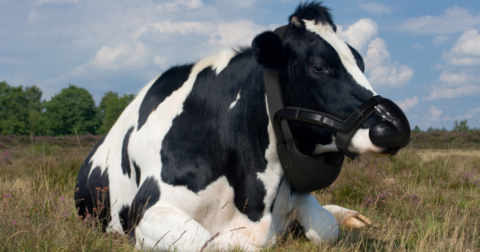Explainer
How Overconsumption Affects the Environment and Health, Explained
Climate•12 min read
Explainer
From methane masks to lemongrass, how do the many efforts to make sustainable beef compare to just eating a little less?


Words by Björn Ólafsson
There are decades of research showing the climate impact of the meat we eat, yet little agreement on how to tackle the problem. Most climate researchers suggest that those of us in the global north need to eat a whole lot less beef. But unsurprisingly, the meat industry hasn’t been so receptive to those recommendations. Instead, the industry has put forward a different approach to the 14.5 percent or so of greenhouse gas emissions linked to meat: to make, and market, a more climate-friendly beef. But just how well do these various approaches to climate-friendly beef work, and how do they compare to just simply cutting back?
These initiatives have plenty of money behind them. Towards the end of 2023, the Bezos Earth Fund announced that 30 million, out of a potential 57 million, would go towards making the livestock sector more sustainable. Most of that money would be spent on “low-methane” feed, genetic breeding programs to make “low-methane” cows, and efforts to improve adoption of “low-methane” farming technologies.
These various efforts to make beef more climate-friendly tend to fall into one or more of the following categories: the feed (additives to food for cows that aim to inhibit their natural methane production), the farm (like reducing food miles and regenerative farming methods) or the way food is labeled.
Feeding cows seaweed first started attracting buzz in 2020. In a nutshell, cows are fed a type of red kelp called asparagopsis taxiformis. This red kelp contains a chemical called bromoform, which changes the metabolic pathways in the cow’s gut so that it can emit less methane. Basically, with more kelp and more bromoform, you’ll get a cow belching less methane. At least, that’s the theory.
The idea received plenty of media attention, including glowing coverage in NPR, the Guardian and Wired. But this solution isn’t as effective as initial news coverage reported. First of all, when tested on real cows on a farm who are only fed a controlled diet for part of their lives, red seaweed is only able to reduce methane emissions by about 28 percent. Plus, the cows on the diet ate less and weighed less at slaughter, which means that more cows need to be slaughtered to keep up with an increasing demand for meat, which in turn ticks those emissions back up again. In other words, the actual decrease in emissions is much lower than 28 percent.
There’s also another problem: the cows don’t like it either. Cows don’t typically eat seaweed — they don’t seem to like the taste and it upsets their digestive system.
The U.S. Department of Agriculture unveiled a new “climate-friendly” beef label last year that has already been applied to a Tyson brand: Brazen Beef. Before the steaks even hit the shelves, journalists raised questions about the label and its climate claims. First, it only claims to reduce emissions by 10 percent — which isn’t much when you consider just how high in emissions beef is as compared to almost any other food. Second, as Kenny Torella points out at Vox, both the USDA and Tyson gave zero evidence for the label’s claims and didn’t respond to journalists’ questions about the scientific basis for their claims.
Regenerative agriculture is among the most difficult practices to analyze because, well, no one can exactly agree on what exactly it is. Broadly, it’s a loose collection of farming methods aimed at improving soil health, which often includes crop rotation, agroforestry and intercropping. But it’s the holistic grazing approach, popularized by Allan Savory in a 2013 TED Talk that's been viewed more than eight million times, that commands a lot of the narrative.
On this type of cattle ranch, large livestock like cows graze large swaths of land, rotating between sections of pasture. Advocates claim that the cows’ hooves improve the plant life in the soil, prevent desertification and even sequester carbon in the soil itself.
But there are several problems with these claims. First, the soil can only capture a finite amount of carbon, meaning this is only sustainable for a certain period of time — usually between 30 and 70 years (less than you need for the strategy to actually “count” as an offset to carbon emissions, which should be permanent, though for practical purposes is often set at 100 years). Second, this method requires far more land, up to 2.5 times more, according to industry-funded research, which comes with a steep climate emissions cost (in short, when you use land for grazing, you incur an opportunity cost from not allowing it to be wild, so it can more effectively store carbon).
Recent research shows that any benefits from soil sequestration in the soil cannot offset ruminant emissions — in fact, soil carbon sequestration would need to improve by 25 to 2,000 percent for any offsetting to be worthwhile. Empirical evidence suggests that rewilding land is far more beneficial than any form of grazing, holistic or otherwise.
In many ways, buying your food from local farms seems an intuitive way to eat planet-friendly — small family farms appear like a natural alternative to industrial agriculture, and the food doesn’t have to travel very far. But while eating locally produced food might benefit your community’s economy, it won’t save the planet. It turns out that only a tiny fraction of the food system’s greenhouse gas emissions come from transportation. For beef, that fraction is somewhere around one percent. Research shows it’s far more effective to cut back on beef, no matter where it’s raised.
Yet 65 percent of Americans still believe that eating local food is better for the environment (that’s twenty percent more that understand that eating less meat benefits the planet.
In 2020, Burger King announced their newest green innovation — beef from cows fed 100 grams of lemongrass to reduce methane emissions by 33 percent for every day the cows were fed the herb — in theory, at least.
The fast food giant started using this statistic in advertising before the research was published or subject to an official peer review process. Even if lemongrass were effective — which is still a big “if” — it only reduces methane while cows are eating it. And it was only fed to cows in the last few months of their lives, meaning overall reductions will be much lower than reductions from limited feeding trials. When we take into account how long the cows are actually fed the lemongrass, the overall reduction is only about 3.6 percent. What’s more, this research has never been replicated successfully, even though a researcher from UC Davis has tried.
Methane masks are what they sound like — hulking technological masks placed on a cow’s snout to trap methane burps and convert them into other forms of gas. These sci-fi contraptions were designed by ZELP, the Zero-Emissions Livestock Project, and are reported to trap half of all methane emitted by cows.
But here too there are problems with putting the theory into actual practice. First of all, just how long the cows will be able to wear these masks is far from clear, and since they only function when worn, they may be only able to trap methane for a short portion of the cows’ lives. Second, the methane is converted into carbon dioxide — which is still a greenhouse gas. The devices also significantly reduce production from dairy cows, which cuts into how many total emissions are saved per carton of milk. And finally, ZELP is interested in selling carbon offset credits to other corporations, relying on carbon markets, which have been criticized as “bogus” and fraudulent.
Some cows have been severely wounded by the devices, while others suffered from bald spots and skin abrasions. Most cows were unable to groom each other while wearing the devices, depriving them of an important social ritual.
ZELP is also unable to provide peer-reviewed research showing how effective their contraptions are, which means the 53 percent figure can’t even be verified. Sentient sent ZELP multiple requests for comment, but the company did not respond.
While corporate fixes like methane masks and feed additives have some effect, the relentless messaging from the meat industry has been successful at obscuring the importance of a global reduction in how much meat we eat, especially in rich countries, where meat consumption is higher and citizens have more access to alternatives. In fact, according to public polling data, 45 percent of Americans don’t think meat is bad for the environment.
It’s clear that with consumption still climbing in many countries, we desperately need a range of solutions. But viable solutions need to be, well, viable. Plant-based meats and cultivated meats have the potential to reduce emissions by 89 percent and 91.4 percent, respectively (although that second figure is a life-cycle prediction for 2030 that assumes facilities will use renewable energy), but the industry has struggled to continue its initial meteoric rise. A number of plant-forward approaches rely more on whole foods, like the “beans is how” movement that aims to incorporate more legumes into diets around the world. Here, not much scale-up is required to put more beans on plates, and they’re already part of many traditional dishes, but it can be hard to convince people to go back to the humble bean. Ultimately, getting people to actually cut back on meat is no simple endeavor, yet we’ve seen some countries like Germany and the UK cut back. Perhaps there the rest of the global north can find some clues for the future.